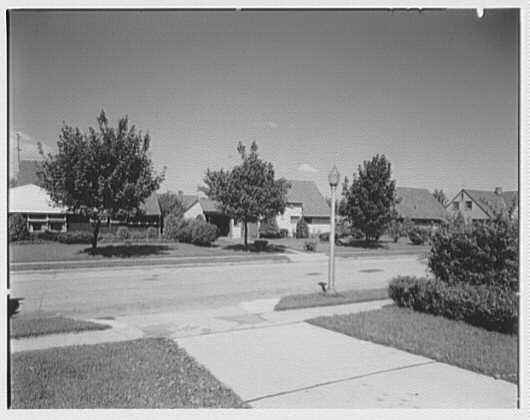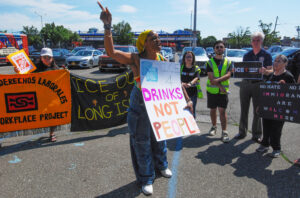By Elisabeth Ford
Editor’s note: Part one in a series looking at segregation on Long Island.
Long Island is home to the first planned suburban community in post-World War II United States — Levittown, in central Nassau County. While the Island might have kick-started suburban life in America, it also brought racial discrimination through restrictive covenants and racial bias in communities like Levittown, from real estate brokers to housing developers, dating back to the 1940s and ’50s through today, but many organizations are working to combat such discrimination now.
Levittown was established in 1951 and advertised as a stable, safe and family-friendly community after the turbulence of World War II. While “safe” was the word so many post-war families sought, its connotation carried with it an insidious underlying message.
The suburban utopia that Long Island provided for families included green grass and white picket fences — but, by and large, was open only to white people. People of all races might have dreamed of the idyllic suburban life, but access was granted only to those of the Caucasian race.
A history of division
In the middle of the 20th century, mass production of small Cape Cod houses that hugged or were close to the Long Island Rail Road began, constructed with assembly-line efficiency, and middle- and upper-middle-class white families quickly started to move in. People of color, in particular Black people, were excluded by covenant. Property deeds had to specify that the owners had to be white.
“If you have seen a racial covenant, it’s pretty amazing because the racial part is just tucked in there. It would be like point 11 of 30 points,” said Timothy Keogh, an assistant professor of history at Queensborough Community College of the City University of New York. “You know, you can’t have your fence too high, you can’t have chickens, you have to mow your lawn, and you can’t sell your house to anyone who is not Caucasian,” he said. “It’s very mundane, even in the language.”
It’s pretty amazing because the racial part is just tucked in there . . . You know, you can’t have your fence too high, you can’t have chickens, you have to mow your lawn, and you can’t sell your house to anyone who is not Caucasian.”
Timothy Keogh, Queensborough Community College
Early on, many developers were skeptical whether homeowners would accept such restrictive language in their deeds. However, “most middle- [and] upper-class white families accepted the restrictions on the use of their property if it meant that their community would be separated by race and class,” said Christopher Neidt, academic director of the National Center of Suburban Studies at Hofstra University.
During the Great Depression, banks struggled to award loans to families seeking to buy homes. At this time, the Federal Housing Administration began lending money to banks to bolster the construction industry. According to Neidt, the overwhelming majority of loans were made in places that bank administrators considered “safe” — communities that were homogeneously white and were not majority Black, not majority immigrant and also not even integrated because, to the FHA, that was a sign of a neighborhood’s “decline.”
While FHA and Veterans Administration (now Veterans Affairs) loans provided “hundreds of thousands, if not millions” of families with proper housing after World War II, Neidt said, they were exclusive to white, middle- to upper-middle-class families.
Abraham Levittown was the developer for whom Levittown is named. “Levitt, as a developer, was known for keeping his communities exclusively white,” Neidt said.
Exclusivity was, and still is, seen by many as a main theme in the value of these neighborhoods. According to Keogh, the FHA, and subsequently real estate agencies, “adopted the idea of, ‘Well, how do we keep this property safe so it doesn’t decline in value and the person buying the home isn’t a risk to not be able to pay the mortgage off?’”
Neidt added that restrictive covenants “were really designed in the early 20th century to maintain exclusivity of upper-middle-class residential communities.”
Meanwhile, rentals on Long Island were — and still are — scarce, with a dearth of apartments, meaning that rental prices are higher than average for those who cannot buy into the housing market. For an African-American family, Keogh said, “it’s going to cost them more to get houses . . . because there’s less options.”
Contemporary segregation
While there are more communities of color here today than there were in 1951, Long Island remains nearly as segregated as ever — and is counted among the most segregated regions of the country. Real estate agents and brokers “still sell the exclusivity. Garden City is sold on the fact that it’s exclusive,” Keogh said. “They continue to perpetuate what has been a standard in real estate for a hundred years or more.”
Although the Fair Housing Act of 1968 legally prohibited discrimination of the sale or rental of housing based on race, “the history of racial discrimination in housing continues in a different way,” said Cam Owens, policy analyst and researcher for the Syosset-based ERASE Racism, an organization combatting racial inequality in housing, education and other sectors.
Exclusionary zoning, for instance, is still a major issue within the housing market, which has been prevalent for almost a century. “The areas which tend to have more inclusionary zoning tend to be areas that are predominantly people of color and tend to be areas of low income,” Owens said. “Imagine if you are a family of color and you are looking for housing, there’s a good chance that you would find affordable housing in an area that has been racialized and that has a racialized concentration of poverty.”
“Total local control of zoning was created for the purpose of segregating people,” said Ian Wilder, executive director of Long Island Housing Services. “Despite passing laws to desegregate, the system to keep segregation in place has not been changed.”
Local control is maintained through town and village zoning boards, which wield great power to decide which housing goes up where.
Wilder is part of one of many organizations combatting racial discrimination in the housing market. “We are working on many fronts to combat the racially motivated imbalance of access to resources,” he said, referring to LIHS’s educational programs to inform the public about federal fair housing laws, and how it advocates “for changes in the laws that tear down existing barriers to access resources based on race.”
According to Wilder, “Systemic racism is the reason for the current lack of affordable housing of crisis proportions.”
While there are “layers upon layers” of causes that have exacerbated and perpetuate housing discrimination, like rent-to-buy predatory schemes and political disempowerment, as Neidt said, “It’s structural inequality, and it’s a hard track to get out of.”








